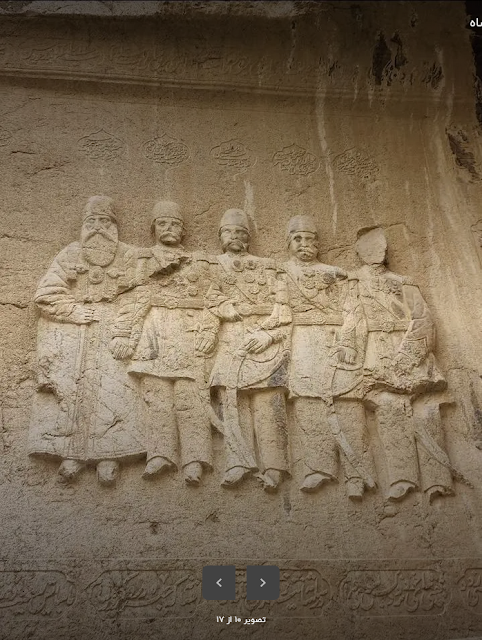The Nasereddin Shah Relief known as Shekl’e Shah (شکل شاه) is a rock relief commissioned by Nasereddin Shah around 1879, showing the shah on horseback flanked by ten standing ministers. It is the latest in a tradition of large rock reliefs ordered by Iranian rulers. It bears some similarities to Savashi Strait that depicts Fath Ali Shah. It is located in the western part of Vana Tunnel at the difficult-to-navigate spot of Tang’e Band Borideh on the Haraz Road. Overlooking the Haraz River, it is about 60 kilometers south of Amol in Mazandaran Province and close to the ruins of an ancient road connecting Ray and Amol on the mountain slope. Of the road itself, the most prominent relic remaining are the two stone half-columns that are erected at quite an altitude above the river.
Nasereddin Shah initiated the renovation and widening of ancient roads in the Haraz and Chaloos valleys. In 1873, he ordered Hossein Ali Khan Vazir, who was supervising the Larijan route in Haraz, along with Gastigir Khan, an Austrian engineer who worked for the Iranian government, to widen the road so that two carriages could pass. When the widening was completed, in 1879, a commemorative bas-relief was created.
The relief is positioned 2.7 meters above the road surface and carved within a rectangular frame eight meters long and approximately four meters high.
It carries an inscription in Persian poetic verses. The scene depicts Nasereddin Shah on a horse between two groups of five courtiers each who are dressed in official costumes with their names written above their heads. Around the outstanding image, there are 16 verses in laudation of Nasereddin shah and the difficulty of passage across the area and the Shah’s dictation about its repair. The names of engineer Mohammad Hossein Mirza, Ragheme Abolfazl (Savogi) and Aliakbar (stone) cutter in addition to 1295 Lunar year are also mentioned.
Despite differences in style, the symbolic and ritual meaning of Iranian bas-reliefs persisted through successive dynasties for millennia. With the arrival of Islam, the relief as a medium was put aside. There followed a gap of more than a millennium before the first Islamic reliefs were created under Fath Ali Shah. In theme and meaning, all of Fath Ali Shah's reliefs represent continuity with the earlier tradition and can be understood in the social and political context of the time, for example, various battles with, and defeat by, Russia. But this relief, although similar in form, it is the only Iranian relief that is simply a commemorative image - a 'photograph on stone'. Indeed, the image resembles actual photographs of Nasereddin Shah and his courtiers.
To access Shekl’e Shah one must stop between the gas station and entrance to Vana Tunnel and continue on foot for 15 minutes along the western bank of the river. Coming from Tehran, the relief is located in close proximity to the tunnel’s second emergency exit. In the course of World War II Russian soldiers used this relief for target practice. During Mohammad Reza Shah’s reign the paved Haraz Road and Vana Tunnel were built in order to avoid the dangerous Tang’e Band Borideh. As a result this bas-relief now stands relatively hidden away from the wandering eyes of passersby. In 2002, the Shekl’e Shah Relief was registered by the Iranian Cultural Heritage Organization .





.jpg)
.jpg)




.jpeg)

No comments:
Post a Comment